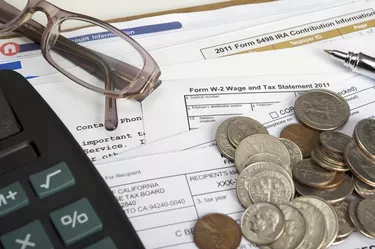
Carrying a staff of employees is a significant responsibility. Orienting, training and supervising can cover issues as diverse as corporate culture, sexual harassment, technical performance, customer service and workplace safety, to name a few.
In addition, businesses must compensate the personnel adequately while providing benefits like medical insurance, unemployment insurance and disability insurance, the premiums of which each are deducted from the regular salary/wages. Also held back are income taxes, at least estimates of what they should be.
Video of the Day
Video of the Day
At the outset of each new year, the company issues a W-2 form to the employee to accompany a tax return. But is there a W-2 minimum amount you need to earn in order to receive this form? It's a good question.
What Is a W-2 Form?
The Internal Revenue Service (IRS) Form W-2 is an official statement made by an employer regarding how much of the worker's annual earnings are subtracted from annual pay to satisfy income tax levies by governments, including federal, state and local. Other deductions are made on the federal level for the funding of Social Security and Medicare accounts.
The W-2 form itemizes these amounts as a way for the taxpayer to file an accurate tax return reflecting total income for the prior year and how much of that was prepaid by the employer. The minimum for W-2 yearly income is $600. Individuals who earn less than the W-2 amount minimum do not always receive a W-2.
Consider also: How to Get W-2s Without Going through the Employer
What If Earn Less than $600?
What if an employee worked only a few days and was terminated, or simply quit or the company folded? If the total compensation amounts to less than $600, is the ex-employee obligated to report that revenue? It all depends on how much money a worker made in a given tax year.
As a rule, any wage earner who brings in less than the standard deduction in a given year is exempt from filing a return. To put that in perspective, a single person, or a married person who opts to file separately from the spouse, was granted a standard deduction of $12,550 in 2021.
If the $599 earned from a short-lived position does not put the taxpayer over that standard deduction cap, no income needs to be reported. A penny over, on the other hand, requires all income to be accounted for.
What About Self-Employment Income?
The W-2 minimum amount does not apply to self-employed people because income tax is not deducted from their earnings as it would be with salaried employees and wage earners. In addition, the self-employment tax is charged to collect for Social Security and Medicare. In many cases, the entrepreneur must track her own revenue in the course of a year and pay the whole income tax since nothing is deducted from her business' receivables.
So, rather than a W-2 form, self-employed business owners get a 1099-NEC form from each client that has paid $600 or more for goods or services rendered. In any event, self-employed persons are obliged to report all business income, even if some is not documented on a 1099. Nevertheless, the minimum earning amount to receive a 1099 is the same as the minimum for W-2.
Consider also: Self-Employed Tax Deductions, Benefits & More
What About the Wage Earner with a Side Hustle?
A salaried employee who might also operate an independent business after hours is subject to the same rules as those who do one or the other exclusively. The minimum income for W-2 is still $600 from an employer, and the floor for any 1099s from clients is also $600.
Minimums afford businesses and companies the latitude to document only for certain levels of financial outlay. To issue tax documents for only a few dollars is overly burdensome.